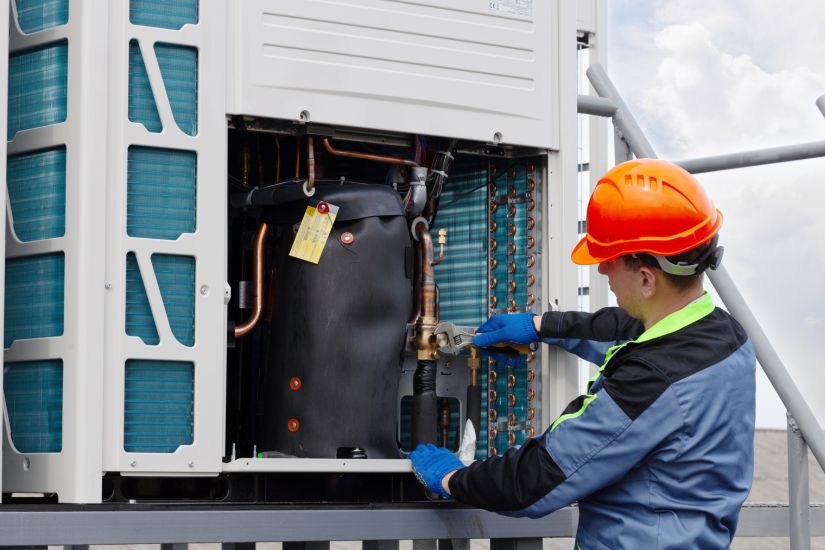HVAC or Heating, Ventilation, and Air-Conditioning systems play the vital role of maintaining indoor temperature, comfort, and air quality. But they’re also highly energy-intensive. Be it a commercial or residential building, these systems can account for up to 60% of the total energy consumed.
And with the rising energy prices and the growing emphasis on sustainability, HVAC energy management is crucial not just for controlling costs but minimizing impact on the environment. This is where an HVAC energy management system can help. In this article, we’ll have a detailed look at these systems, their benefits, and more.
What are HVAC Energy Management Systems?
Popularly known as Building Energy Management Systems (BEMS) or Energy Management Systems (EMS), it is an automated and centralized platform used for monitoring, controlling, and optimizing HVAC systems.
These advanced systems are nothing like your standalone thermostats or controllers. They can collect data from various meters, sensors, and subsystems to optimize the functioning of HVAC systems in real-time. You can think of them as your HVAC setup’s “brain” that collects data, analyzes it, and makes the necessary adjustments as and when required to ensure maximum efficiency and minimum energy waste.
The core objectives of any building energy management system for HVAC are-
- Minimizing energy consumption
- Maintain utmost comfort for the occupants
- Support compliance and sustainability objectives
- Extend the lifespan of HVAC systems
What are the Various Components of an HVAC Energy Management System?
Meters and Sensors
HVAC EMS integrates several software and hardware components that seamlessly function to deliver the expected results. The core components are-
If the EMS is the “brain” of an HVAC unit, the meters and sensors are eyes and ears. From collecting and transmitting data on temperature, CO2 levels, air quality, and humidity to tracking energy consumption in different parts of the building, it is these sensors and meters that do all the hard work.
Common types of sensors and meters include-
- Temperature
- CO2
- Humidity
- Airflow
- Pressure
- Occupancy
Controllers
The controllers in an energy management system are responsible for making the decisions. The data collected by the sensors and meters is sent to these controllers. The received data is analyzed based on a pre-defined set of rules or logic for making the decisions.
There are basically two different types of controllers- Local controllers responsible for controlling environments of specific zones and central controllers that are integrated into Building Management Systems (BMS) for coordinating the overall indoor environment of the building.
Building Management System (BMS)
The BMS supervises the functioning of different subsystems installed in the building. Right from your HVAC, lighting, elevators, to security, it is the central unit for supervising all the systems.
It has a central dashboard that can be used by facility managers for visualizing performance data, receiving alerts, and setting schedules.

Cloud-based Software with AI
To enable remote monitoring, most of the latest energy management systems come with cloud connectivity. You can also find systems integrated with Artificial Intelligence (AI) and advanced analytics to enable predictive maintenance and identify efficiency gaps.
5. Dashboard or User Interface
Last but not the least is the dashboard. It offers intuitive visualization for actionable insights. Energy trends, live metrics, and alerts can be seen on this dashboard. Many of the modern systems also come with mobile apps for on-the-go energy management.
What are the Benefits of Installing an Energy Management System?
Some of the top reasons include-
Cost Reduction
Needless to say, the primary benefit of installing BEMS is the cost savings. Studies suggest these systems can reduce building energy consumption by 15% to 30%.
And how do they do it? Here’s a basic example- Let’s assume the meeting in a conference room is concluded, and now the room is empty. The sensor will transmit this signal to the system, which in turn will reduce the cooling and ventilation in the room to save electricity.
Improved Energy Efficiency
From the example above, it is easy to understand that a BEMS ensures the HVAC unit only works when required.
With features like real-time optimization and demand-based control, they help minimize energy waste, especially during peak hours.

Higher Occupant Comfort
As factors like temperature, air quality, and humidity are precisely managed in real-time, HVAC system optimization for energy management also ensures utmost occupant comfort.
From optimal air quality to reduced hot and cold spots, your occupants are sure to enjoy the indoor environment at all times.
Predictive Maintenance
Thanks to constant data monitoring, BEMS detects anomalies such as uncommon temperature fluctuations and higher energy consumption, which are often the early signs of upcoming system failure.
The system can raise alarms to alert the maintenance team before the breakdown occurs. This can also reduce downtime and prevent emergency repairs or replacements that are generally expensive.
Compliance and Sustainability
An energy-efficient building emits lower carbon into the environment. With the help of an HVAC energy management system and its features like monitoring sustainability metrics, you can also make buildings comply with BREEAM, WELL, or LEED standards.
What is the Cost of Installing an HVAC Energy Management System?
The installation cost can vary significantly based on factors like the size of the building, technology requirements, and installation complexity. However, here is a basic breakdown to help you get an idea-
Average Installation Cost
- Small to Medium-sized Commercial Buildings- $40,000 to $100,000
- Larger Buildings- $100,000 to over $500,000

Component Costs
- Meters and Sensors- $5,000 to $15,000
- Automation Hardware and Controllers- $5,000 to $20,000
- Software License- $5,000 to $10,000
- Cloud Compatibility- Up to $10,000
- Integration and Setup- $20,000 to $50,000
- Training and Maintenance- $2,000 to $5,000
Return on Investment
As a property owner or facility manager, ROI is also a vital consideration for you. For an HVAC energy management system, paybacks are generally within 2 to 3 years through energy savings, lower maintenance requirements, and higher equipment life.
Over time, the BEMS can deliver long-term returns that often exceed 200% with sustained energy efficiency.
Are There Any Challenges in Implementing Energy Management Systems?
Even though there are significant long-term advantages, there can be a few initial challenges like-
- Upfront Investment- As mentioned above, implementing BEMS is capital-intensive. But within a period of 2-3 years, you should be able to recoup the investment and continue considerable savings every year for the foreseeable future.
- Legacy System Integration- If you have an older HVAC setup, it might not be compatible with one of the modern BEMS. Upgrades or retrofits might be required.
- Data Management- You’ll also need a decent IT infrastructure for handling the large amounts of data generated by these systems.
- Staff Training- It is also essential for your staff to know how to use the system in order to take maximum advantage.
Enhance HVAC Performance with Energy Management Systems
If your aim is to reduce energy costs, maintain higher indoor comfort, and meet sustainability goals, an HVAC energy management system is an absolute must. Be it a commercial building, corporate campus, or a hospital, these systems can unlock significant long-term savings and extend equipment life.
A leading company like Operational Intelligence, with its extensive experience in deploying Building Management Systems, can help buildings evaluate their current HVAC infrastructure, identify efficiency gaps, and deploy custom BEMS solutions. From selecting the right system to its deployment and maintenance, they can ensure your building masters energy efficiency.





